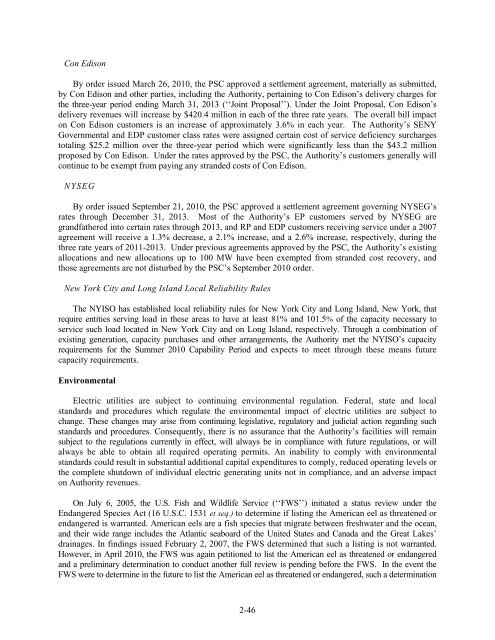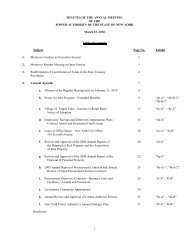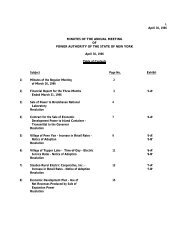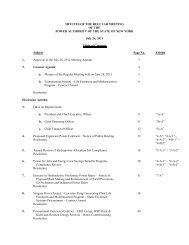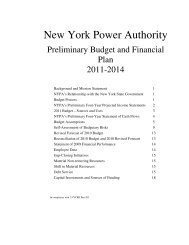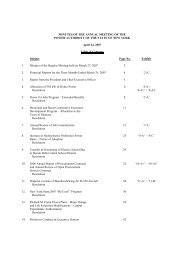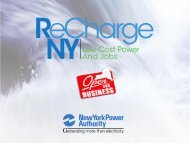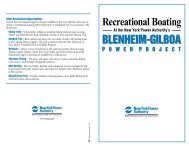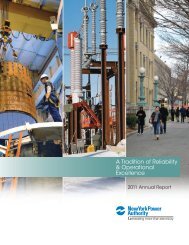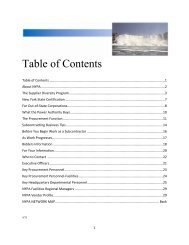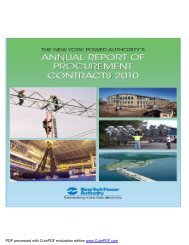July (pdf) - New York Power Authority
July (pdf) - New York Power Authority
July (pdf) - New York Power Authority
Create successful ePaper yourself
Turn your PDF publications into a flip-book with our unique Google optimized e-Paper software.
Con Edison<br />
By order issued March 26, 2010, the PSC approved a settlement agreement, materially as submitted,<br />
by Con Edison and other parties, including the <strong>Authority</strong>, pertaining to Con Edison’s delivery charges for<br />
the three-year period ending March 31, 2013 (‘‘Joint Proposal’’). Under the Joint Proposal, Con Edison’s<br />
delivery revenues will increase by $420.4 million in each of the three rate years. The overall bill impact<br />
on Con Edison customers is an increase of approximately 3.6% in each year. The <strong>Authority</strong>’s SENY<br />
Governmental and EDP customer class rates were assigned certain cost of service deficiency surcharges<br />
totaling $25.2 million over the three-year period which were significantly less than the $43.2 million<br />
proposed by Con Edison. Under the rates approved by the PSC, the <strong>Authority</strong>’s customers generally will<br />
continue to be exempt from paying any stranded costs of Con Edison.<br />
NYSEG<br />
By order issued September 21, 2010, the PSC approved a settlement agreement governing NYSEG’s<br />
rates through December 31, 2013. Most of the <strong>Authority</strong>’s EP customers served by NYSEG are<br />
grandfathered into certain rates through 2013, and RP and EDP customers receiving service under a 2007<br />
agreement will receive a 1.3% decrease, a 2.1% increase, and a 2.6% increase, respectively, during the<br />
three rate years of 2011-2013. Under previous agreements approved by the PSC, the <strong>Authority</strong>’s existing<br />
allocations and new allocations up to 100 MW have been exempted from stranded cost recovery, and<br />
those agreements are not disturbed by the PSC’s September 2010 order.<br />
<strong>New</strong> <strong>York</strong> City and Long Island Local Reliability Rules<br />
The NYISO has established local reliability rules for <strong>New</strong> <strong>York</strong> City and Long Island, <strong>New</strong> <strong>York</strong>, that<br />
require entities serving load in these areas to have at least 81% and 101.5% of the capacity necessary to<br />
service such load located in <strong>New</strong> <strong>York</strong> City and on Long Island, respectively. Through a combination of<br />
existing generation, capacity purchases and other arrangements, the <strong>Authority</strong> met the NYISO’s capacity<br />
requirements for the Summer 2010 Capability Period and expects to meet through these means future<br />
capacity requirements.<br />
Environmental<br />
Electric utilities are subject to continuing environmental regulation. Federal, state and local<br />
standards and procedures which regulate the environmental impact of electric utilities are subject to<br />
change. These changes may arise from continuing legislative, regulatory and judicial action regarding such<br />
standards and procedures. Consequently, there is no assurance that the <strong>Authority</strong>’s facilities will remain<br />
subject to the regulations currently in effect, will always be in compliance with future regulations, or will<br />
always be able to obtain all required operating permits. An inability to comply with environmental<br />
standards could result in substantial additional capital expenditures to comply, reduced operating levels or<br />
the complete shutdown of individual electric generating units not in compliance, and an adverse impact<br />
on <strong>Authority</strong> revenues.<br />
On <strong>July</strong> 6, 2005, the U.S. Fish and Wildlife Service (‘‘FWS’’) initiated a status review under the<br />
Endangered Species Act (16 U.S.C. 1531 et seq.) to determine if listing the American eel as threatened or<br />
endangered is warranted. American eels are a fish species that migrate between freshwater and the ocean,<br />
and their wide range includes the Atlantic seaboard of the United States and Canada and the Great Lakes’<br />
drainages. In findings issued February 2, 2007, the FWS determined that such a listing is not warranted.<br />
However, in April 2010, the FWS was again petitioned to list the American eel as threatened or endangered<br />
and a preliminary determination to conduct another full review is pending before the FWS. In the event the<br />
FWS were to determine in the future to list the American eel as threatened or endangered, such a determination<br />
2-46


